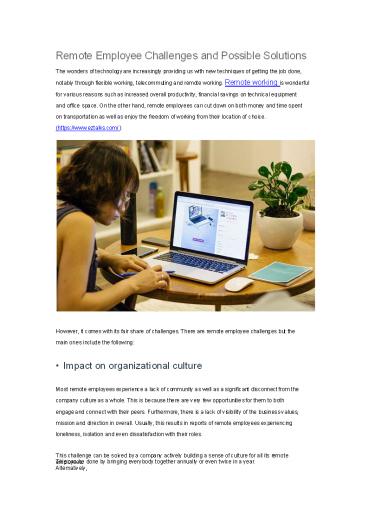ezTalks: The Common Challenges of Remote Employee - PowerPoint PPT Presentation
Title:
ezTalks: The Common Challenges of Remote Employee
Description:
The wonders of technology are increasingly providing us with new techniques of getting the job done, notably through flexible working, telecommuting and remote working. Remote working is wonderful for various reasons such as increased overall productivity, financial savings on technical equipment and office space. On the other hand, remote employees can cut down on both money and time spent on transportation as well as enjoy the freedom of working from their location of choice. ( ) – PowerPoint PPT presentation
Number of Views:6
Title: ezTalks: The Common Challenges of Remote Employee
1
Remote Employee Challenges and Possible
Solutions The wonders of technologyare
increasingly providing us with new techniques of
getting the job done, notably through flexible
working, telecommuting and remote working. Remote
working is wonderful for various reasons suchas
increased overall productivity, financial savings
on technical equipment and office space. On the
other hand, remote employees can cut down on both
money and time spent on transportation as well as
enjoy the freedom of working from their location
of choice. (https//www.eztalks.com/ )
- However, it comes with its fair share of
challenges. There are remote employee challenges
but the main ones include the following - Impact on organizational culture
- Most remote employees experience a lack of
community as well as asignificant disconnect from
the company culture as a whole. This is because
there are very few opportunities for them to both
engageand connect with their peers. Furthermore,
there is a lack of visibility of the business
values, mission and direction in overall.
Usually, this results in reports of remote
employees experiencing loneliness, isolation and
even dissatisfaction with their roles. - This challenge can be solved bya company actively
building a sense of culture for all its remote
employees.
This can be done by bringing everybody together
annually or even twice in a year. Alternatively,
2
- companies can use the services of effective video
conferencing software like ezTalks Cloud Meeting
to encourage such connections. This will allow
remote employees to build interpersonal - relationships and even communicate better via
non-verbal cues by seeing their peers. In
addition to using - effective video conferencing softwaresuch as
ezTalks Cloud Meeting, companies can use their
intranet or social tools to provide insightsand
updates of their culture, values and vision,
business updates, share employee recognition and
even daily office proceedings to facilitate a
sense of inclusion. - Visibility and accountability
- Remote employees may overwork by putting more
hours compared to their in-house counterparts in
an effort toshow productivityand be visible.
Thismeans that remote employees will experience
challenges in prioritizing work as well as
gaining insight into broader picture business
objectives or priorities. This can ultimately
result in dissatisfaction, burnout and finally in
staff turnover. Furthermore, lack of physical
presence and visibility can make remote employees
to miss out on day-to-day recognition awarded to
their in-house counterparts. - This challenge can be solved by the clear
definition of deliverables and expectations. This
can be achieved - by establishing check-in points or benchmarks
that managersand remote employees can utilize to
discuss achievementsand progress. In addition,
centralized projectmanagement or digital
collaboration tools can be used to provide
increased visibility concerning where remote
employees are up to as well as - their work. Intranets or social platforms can
facilitate peer-to-peer recognition, this ensures
that even remote employees become visible and are
celebrated in public arenas. - Security
- Remote employees facevery different risks from
those based in the office when theyare working
home alone, in shared spaces or when theyare
using public networks to access business systems.
Thismeans that information, data and employees
themselves suffer from a security risk when
working remotely.
security and the importance of installing
protective software like antivirus emphasized to
them.
3
- iii. Companies should also develop emergency
check-in protocols to be followed in case or a
crisis or physical disaster. - Work-life boundaries
- Remote employees have a high likelihood of
beingvictims of home interruptions. Lack of a
physical boundary between home environment and
work environment can lead to longer working hours
or even unpredictable working time, increased
stress levels as well as strain on both
professional and personal relationships. - To solve this problem, companies can carry out
additional trainingand support in regard to
productivity, time management as well as the
ability tomeet expectations. This is for the
employees who are sourced from in-house. However,
it isalways advisable to hire remote employees
rather than to roll out remote working for the
existing in-house employees. This is because
possess experience - in telecommunication andare therefore better
equipped to meetsuch challenges. Furthermore, - expectations can be clarified and establishing a
protocol that indicates when remote employees are
actually working. Remote employees can also
easilyset up a dedicated space either externally
or at home to establisha physical boundary
between work and life. - Communication concern
- This has to be among the greatest difficulties
that remote employees experience. There are
logistical challenges that people who work in
different countries or time zones experience. - The best way by which to coordinate remote
employees is to utilize various digital channels.
There is - instant messaging, forums, fail-safe mail and vid
eo call software like ezTalks Cloud Meeting.
These can streamline communication by eliminating
these barriers. This will allow managers to reach
out on a daily basis and for remote employees to
receive supportand ask questions.
From https//www.eztalks.com/telecommuting/remote
-employee-challenges.html































